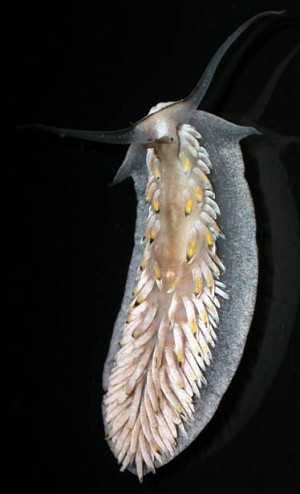Cerberilla asamusiensis from sthrn Queensland
September 4, 2009
From: Gary Cobb

Concerning message #7457:
Hi Bill and everyone!
Great to see you're back in the Nudibranch Saddle! I wish to present to the Forum a species I find pretty incredible.
While sieving the white sand off the shore of Bulwer Beach, Moreton Island in about 4 m of water, I "uncovered" Cerberilla asamusiensis!
Locality: Bulwer Beach, Moreton Island, 4 m, Queensland Australia, Pacific Ocean, 12 July 2009, Subtidal. Length: 23 mm. Photographer: Gary Cobb and David Mullins
Got the animal onto the boat where it started immediately laying eegs. I have included a closeup photo of the eggs and they appear to be dividing after only 2 hours. Can this be? Is it possible the egg is born in multiple yokes?
I have also included a closeup of the cerata. The digestive organ is clearly visible.
This species has the widest foot I have seen.
Cheers
Gary
gary@nudibranch.com.au



Dear Gary,
This is an interesting find. It certainly looks like C. asamusiensis, which would make this a huge range extension from Japan. The egg ribbon is also very interesting as we have little information on the biology of any species of these sand-dwelling aeolids. Looking at the eggs, some seem seem to have divided past the 4 cell stage so I am pretty sure this is egg division rather than cluster of 4 discrete eggs in each capsule. Not all nudibranchs lay their eggs at the single cell stage. I have observed some species of Pupa, such as Pupa kirki, delaying laying until the eggs were just about to 'hatch' as free -swiming veliger larvae. I guess if you are a sand-dweller and it is difficult to find 'safe' permanent structures to stick your egg ribbon to, there is an advantage in keeping the eggs until they are a late embryo. In this way they are less likely to be washed away from their preferred habitat.
Best wishes,
Bill Rudman
Related messages
-
Re: Cerberilla asamusiensis from the Japan Sea
From: Shigeru Hayashi, July 22, 2002 -
Cerberilla asamusiensis from The Japan Sea
From: Shigeru Hayashi, July 13, 2002
